ASUS UX31A: Putting the Ultra in Ultrabooks
by Jarred Walton on August 28, 2012 9:00 AM EST- Posted in
- Laptops
- Intel
- Asus
- Ivy Bridge
- Zenbook Prime
- Ultrabook
ASUS UX31A: Battery Life
Battery life is one of the more important aspects of an Ultrabook, given their focus on mobility. The UX31A doesn’t do quite as well as other Ultrabooks in this aspect, but that appears to be the price of entry for the 1080p display. Even so, battery life isn’t a huge issue, as we’re still in the range of being able to run all day without the need to plug in.
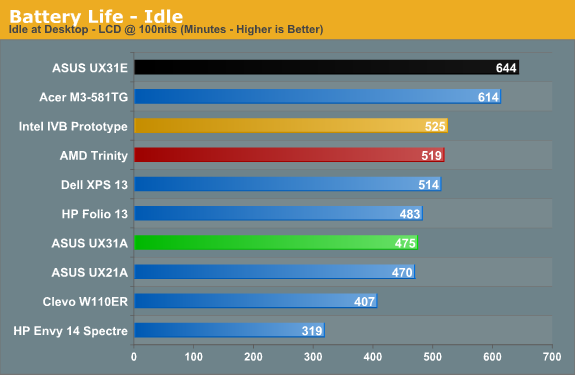
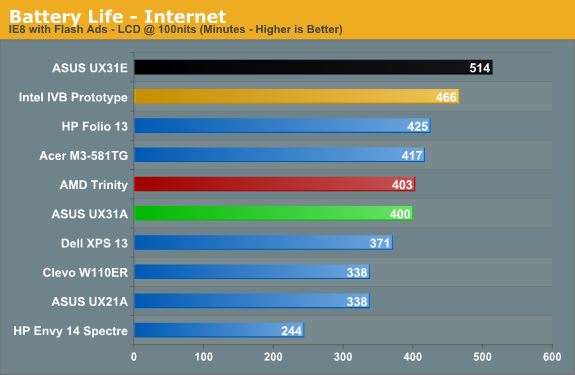
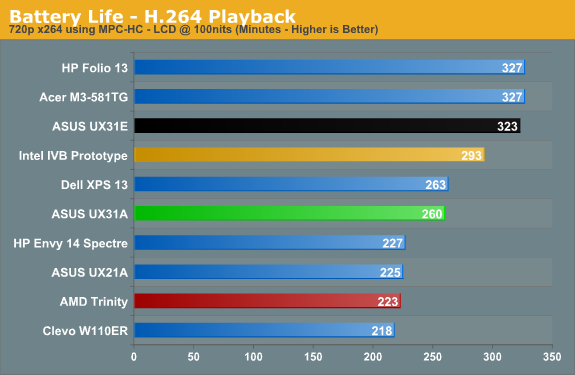
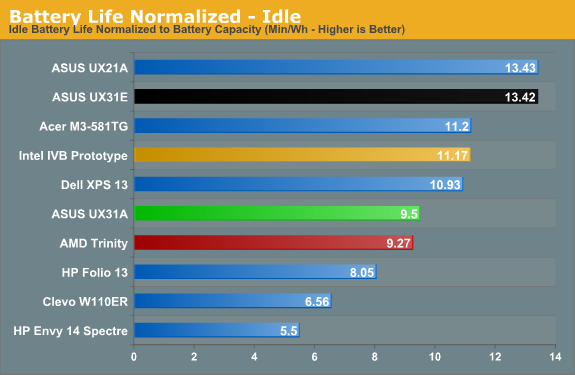
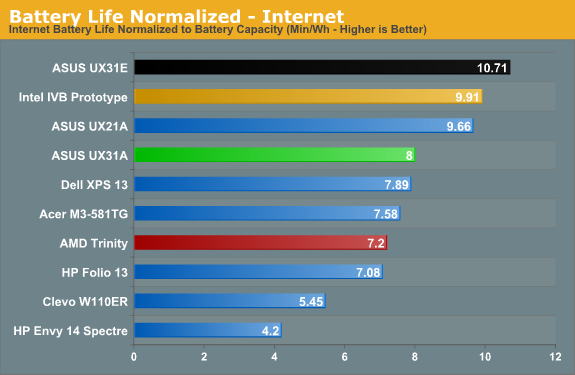

We’ve seen several 13.3” Sandy Bridge Ultrabooks deliver better battery life, while the Ivy Bridge offerings so far appear to cluster together. The prototype Ultrabook did better in all three of our battery tests, but at the same time the UX31A surpasses both the Acer S3 and its little brother the UX21A. In the case of those last two, of course, we’re looking at a 50Wh battery capacity compared to 35Wh, which means when we look at normalized battery life, things aren’t quite so good. Unless you want more than six or so hours of useable battery life, though, the UX31A should be sufficient.
Just make sure to plug the UX31A in at night, as like most laptops it will still require several hours to recharge. Actually, that’s not entirely correct: ASUS has implemented a quick-charge feature where the battery can reach 80% of its maximum in under two hours (110 minutes)—and that’s with the laptop powered up and the LCD at 100% brightness. The final 20% charge will require another 80 minutes or so, which means you’ll need about 3.5 hours of charging to go from a fully drained battery to a 100% charge.
And speaking of running the LCD at 100% brightness, I did a quick test to see how much that would impact battery life in our idle test. This is actually a perfectly valid use case for someone working outside or in a car, and the result is a drop from 475 minutes to 295 minutes. Going with the 50Wh rated capacity of the battery, that means the LCD uses an extra ~3.9W when set to 100% brightness instead 28% (100 nits). That might not seem like much, but keep in mind that at 100 nits the entire laptop consumes around 6.2W, so the LCD can easily account for over a third of the total power draw in light workloads.
Overall, battery life is good if not exceptional. Depending on how bright you want to run the LCD, you can get anywhere from five to eight hours of light use out of the UX31A. We’ve certainly seen better batter life elsewhere, but the loss in raw battery life is a small price to pay for what is, in our experience, the best 13.3” LCD you can currently find in any laptop—Ultrabook or otherwise.


_575px.jpg)








106 Comments
View All Comments
JarredWalton - Tuesday, August 28, 2012 - link
I didn't see any stickers, so you should be able to remove the HSF with a bit of effort. I didn't try to do this but the screws are easily accessible. I should note that I tried to disconnect the battery plug and gave up for fear of breaking something, though, so maybe it won't be so easy. LOLj_c - Tuesday, August 28, 2012 - link
"and stay away from the SanDisk U100 if you want decent SSD performance"More details on that particular issue would be nice.
Do you know a way to distinguish between these two models?
JarredWalton - Tuesday, August 28, 2012 - link
AFAIK, ASUS is not shipping the U100 any longer because of the performance issues. You can see where the UX31E and UX21A (with U100) rate in the PCMark 7 Storage suite -- basically the slowest SSD solution we've tested recently. What I don't know is whether ASUS figured out something with the ADATA SF-2281 firmware; I never experienced errors, but the BSOD issue still remains on some laptops/desktops.j_c - Thursday, August 30, 2012 - link
Very interesting, because over here in Germany, it seems the Sandisk model is the only one available. One commenter on amazon.de cites a call by Asus Customer Support, that no ADATA models will be available for now.JarredWalton - Saturday, September 8, 2012 - link
Apparently there are plenty of U100 equipped units shipping; I've updated the conclusion.Shadowmaster625 - Tuesday, August 28, 2012 - link
Can anyone make an educated guesstimate on how much a typical ultrabook would cost if it included this specific display, only a 128GB SSD, 4GB of RAM and the cheapest trinity A8?JarredWalton - Tuesday, August 28, 2012 - link
How much to make or how much it would sell for? In terms of BoM costs, it would probably be around $100 less than the Core i5 version ASUS is selling right now. Retail pricing is the real question. Right now, HP's Sleekbook 6z-1000 sells for $225 less than the Intel i5-3317U variant, but that's also with the A6-4455M which would be substantially slower than full voltage A8. The A10-4655M ought to be reasonably fast in graphics vs. Intel ULV, but we haven't been able to test it and it's $100 more than the A6 version ($125 less than Intel).The big problem is that no one is making 13.3" AMD-based "sleekbooks" that I know of -- links if you have them, please. And in fact, their AMD Sleekbooks are the worst thing I can think of: a 15.6" 1366x768 display with an ultra-thin form factor. Do people want 15.6" thin laptops that much? I feel most people going for ultra-thin are going to want 14" or smaller.
Actually, the biggest problem is getting someone to make a 13.3" AMD laptop with a premium quality LCD. It's possible in theory, but getting the bean counters to agree to spend $100 more or whatever for a "premium" IPS 1080p display while going with a "budget" AMD APU is a very long shot. Heck, getting premium displays in consumer laptops in general is hard enough -- the 1080p UX21A/UX31A/UX32VD are the exception. Others might follow ASUS' lead in the future, but I expect all the quality LCDs to reside in $1000+ laptops for a while yet.
ReverendDC - Tuesday, August 28, 2012 - link
I understand that SSD is faster, but I would like more mention of the dependability or lack therein of SSD. I am not sure of the warranty on this device, but if it is a year, you may have issues, especially if you move large chunks on and off the drive regularly (as you probably would for movies and music when taking the laptop on travels). Most SSDs have a warranty of three years, and even AnandTech has stated that you should expect about 5 years of storage, but anything more is gravy.I have 15 year old spinning platters that still give data, although there are some bad sectors starting to crop up. Obviously, I am not willing to go backwards, but SSD is not the best use case in every scenario, especially if data fidelity is a top requirement, even if it is much speedier. What we really need is a price cut in SLC modules, which are far more reliable, with better capacity.
That being said....thanks for the great review. Informative as always.
JarredWalton - Tuesday, August 28, 2012 - link
SSD durability is still far greater than five years for all but the most strenuous use cases, so I'm not too concerned about that. If you're constantly writing data to SSDs, you can burn through it faster, but Anand did some testing where he calculated even extreme use cases would still last five years. Five years from now, I suspect other areas of the laptop are likely to be failing (fans, hinges, whatever), and when an SSD runs out of cycles you can still read data off of it.Kristian Vättö - Tuesday, August 28, 2012 - link
As we have stated in numerous SSD reviews, the endurance of current MLC NAND is not a problem for consumer use.